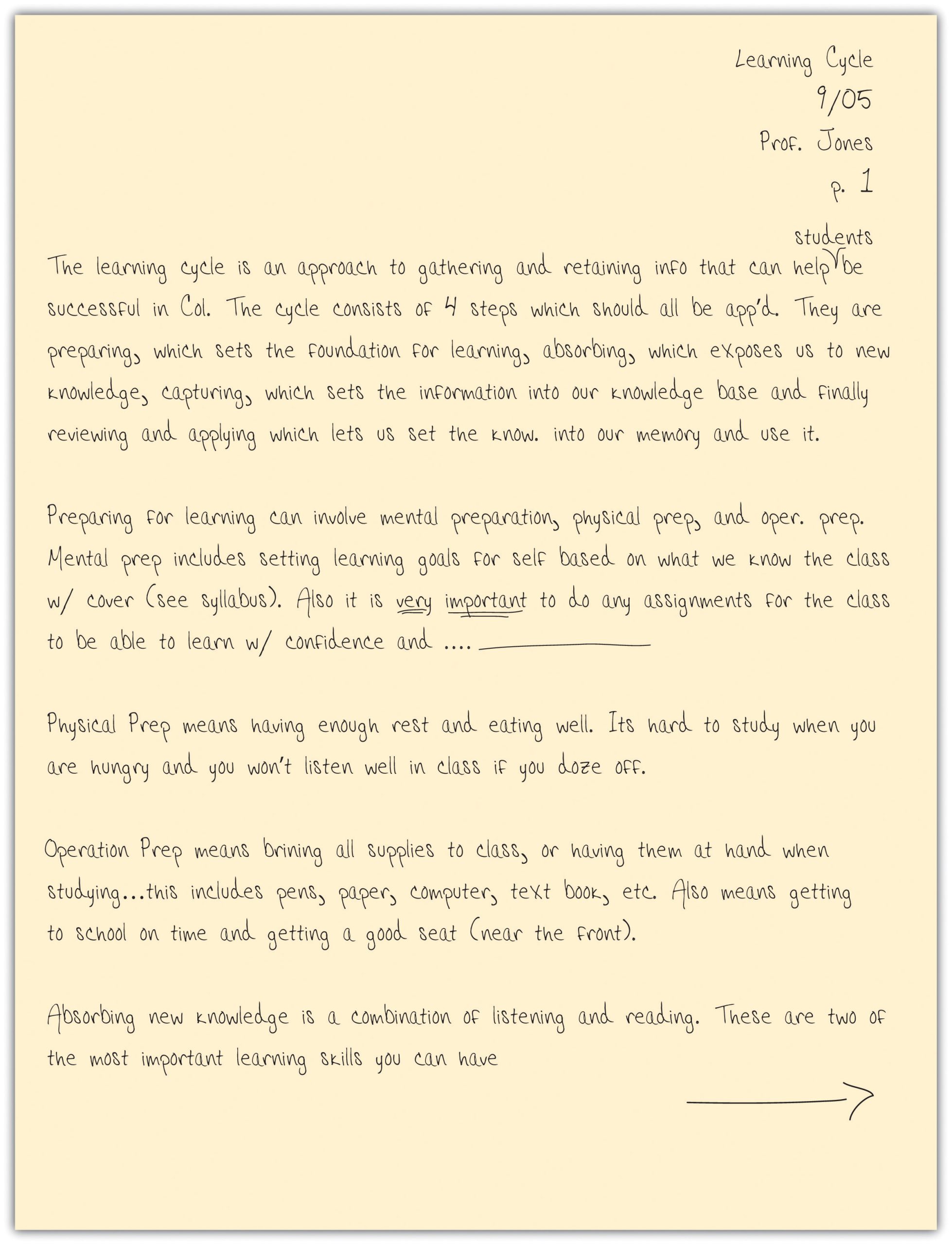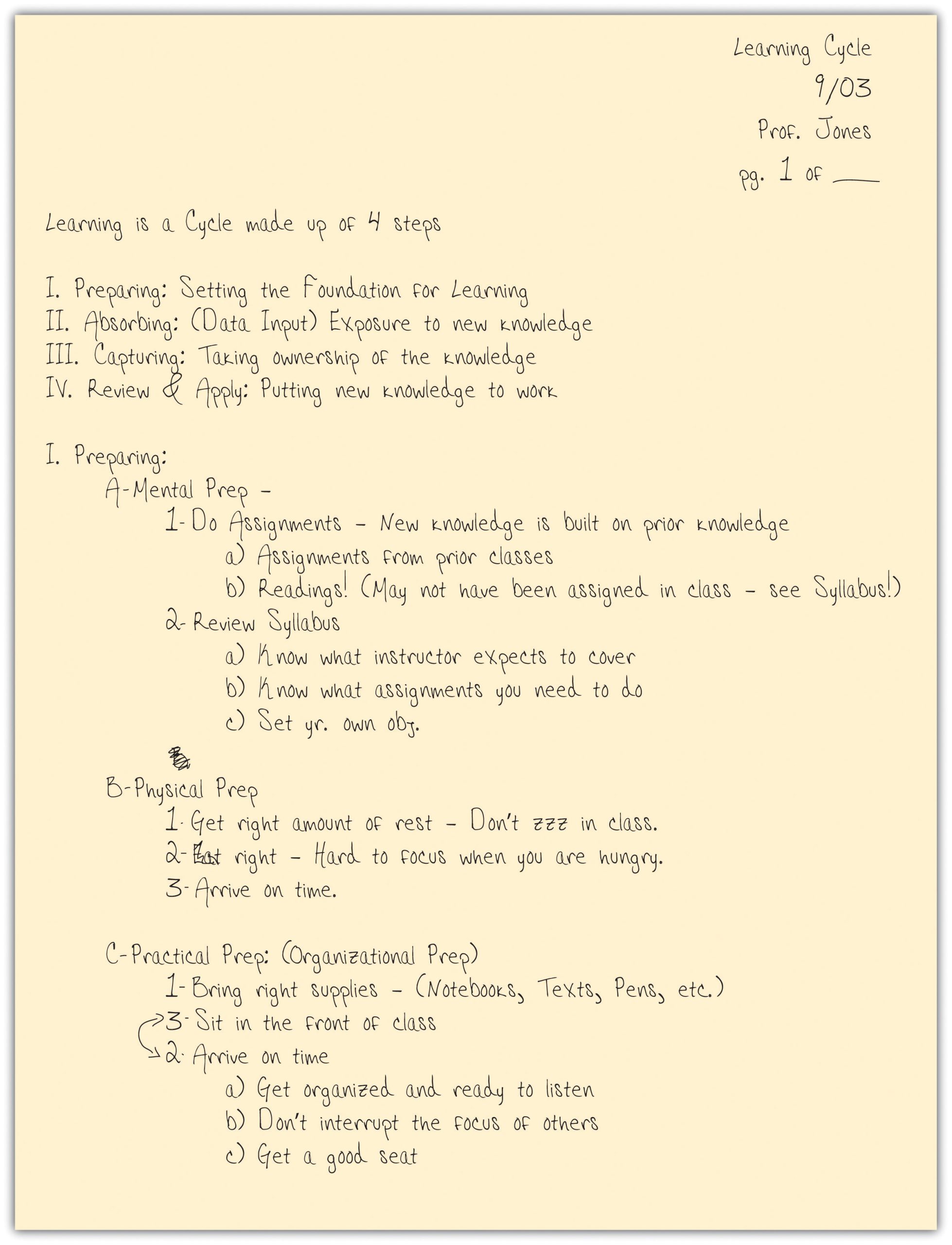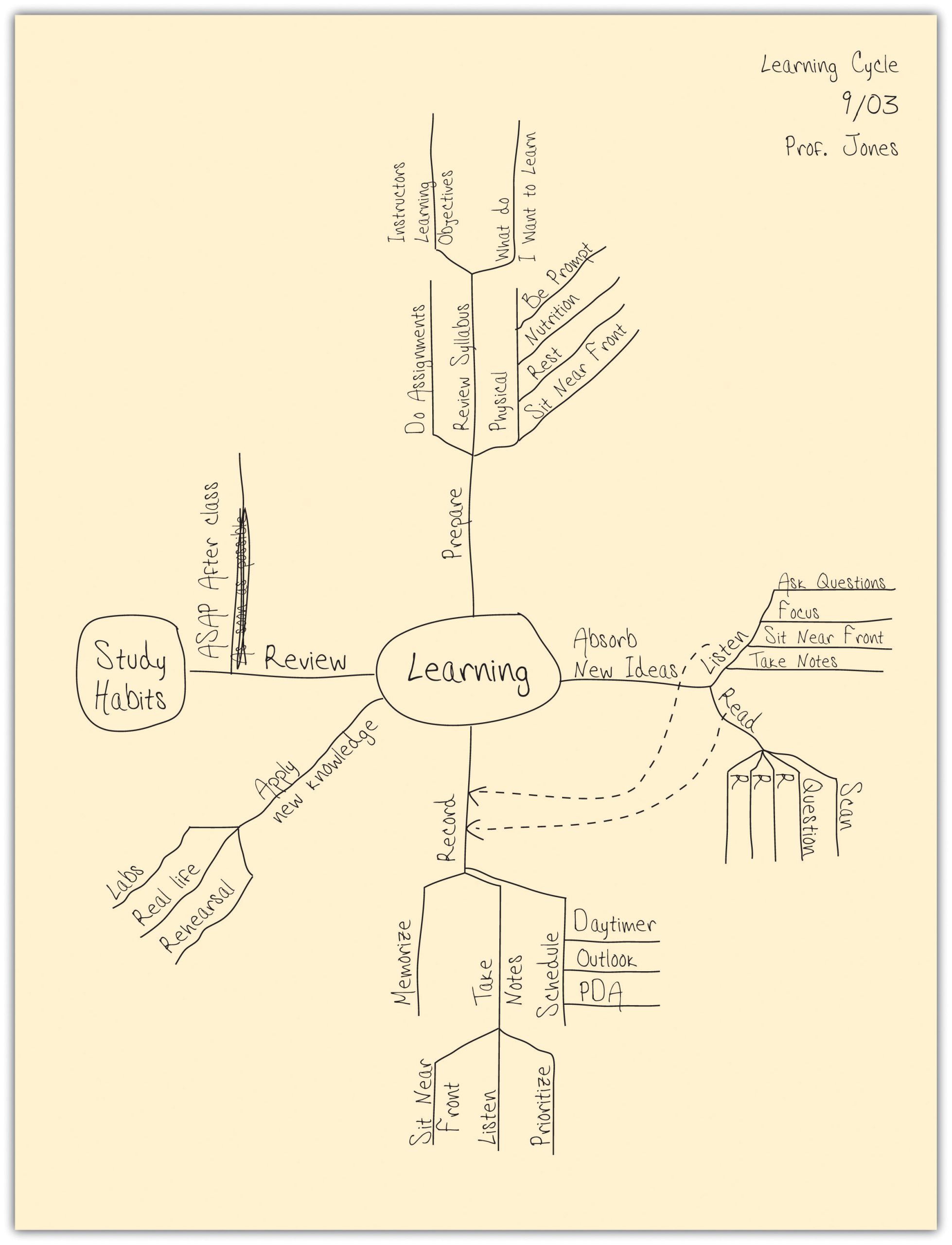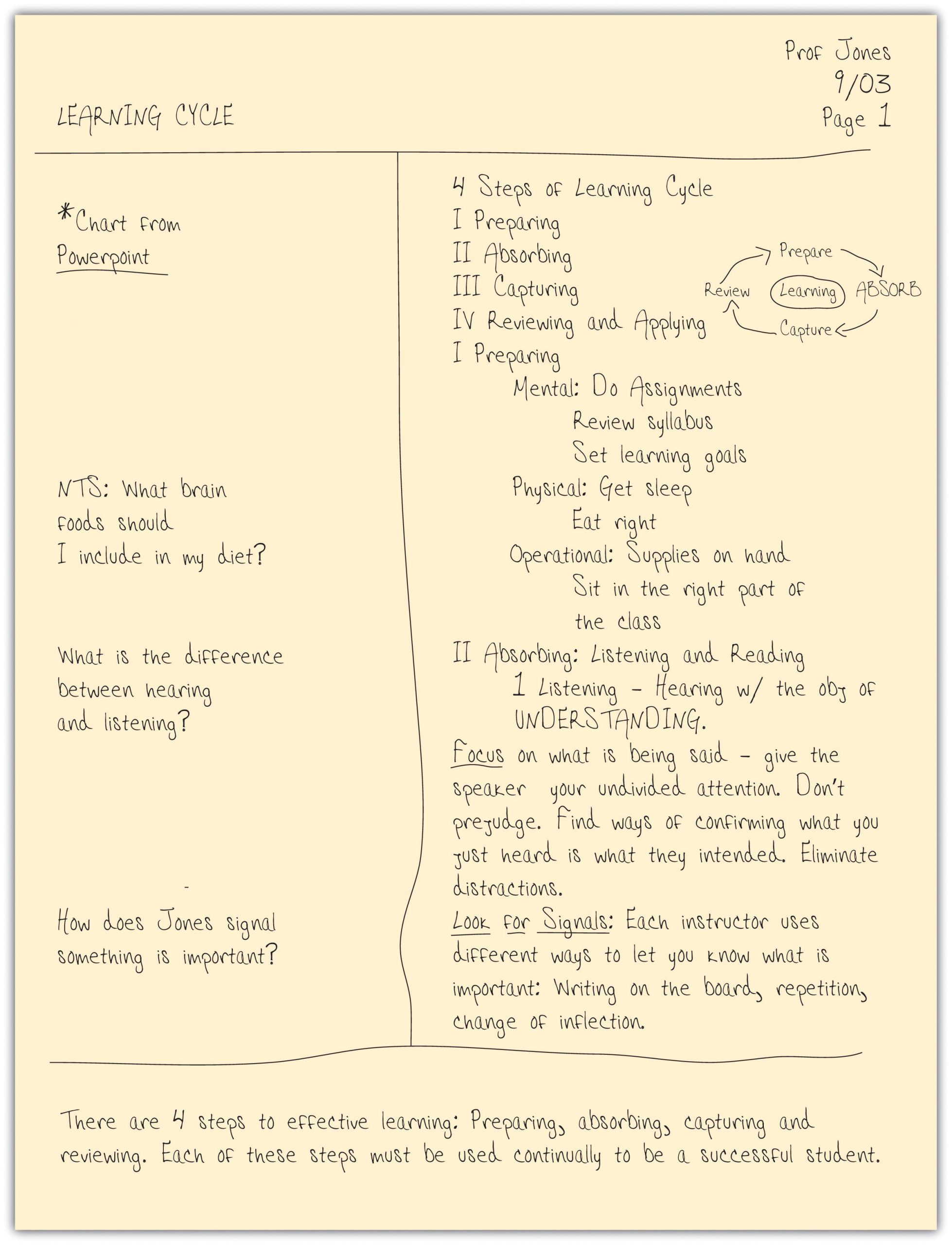Effective Note-Taking
Learning Objectives
By the end of this chapter, you will be able to:
- Explain why taking notes is important.
- Describe effective strategies for taking notes during lectures.
- Explain the optimal time for reviewing lecture notes.
- Use the four primary methods of note-taking: lists, outlines, concept maps, and the Cornell method.
- Select a method of note-taking from various examples.
- Apply strategies to make note-taking more effective.
- Use effective strategies if you happen to miss a class.
- Organize your notes into effective study guides.
- Use teacher handouts to complement your notes.
- Determine what to do with your course notes after the course is complete.

You have the PowerPoint slides from your instructor’s lecture, and the information in your textbook. Do you need to take notes as well?
Despite the vast amount of information available in electronic formats, taking notes is an important learning strategy. Also, how you take notes matters. Not all note-taking strategies lead to equal results.
Everybody takes notes, or at least everybody claims to. But if you take a close look, many who say they take notes on their laptops are actually surfing the Web, and paper notebooks are filled with doodles interrupted by a couple of random words with an asterisk next to them reminding you that “This is important!”
In nursing school, these approaches will not work. In nursing school, your instructors expect you to make connections between reading assignments and class lectures. They expect you to have questions about the material presented. They expect you to make connections between the material and life beyond nursing school. Your notes are your road maps for these thoughts. Do you take good notes? After learning to listen, note-taking is the most important skill to ensure your success in a class. By considering your note-taking strategies carefully, you will be able to create a set of notes that will help you retain the most important concepts from lectures and tests, and that will assist you in your exam preparation.
Effective note-taking is important because it:
- supports your reading and listening efforts,
- allows you to test your understanding of the material,
- helps you remember the material better when you write key ideas down,
- gives you a sense of what the instructor thinks is important,
- creates your “ultimate study guide.”
Two Purposes for Taking Notes
People take notes for two main reasons:
- To keep a record of the information they heard, read, or experienced. This is also called the external storage function of note-taking.
- To help them learn the material they are currently studying.
The availability of information on the internet reduces the importance of the external storage function of note-taking. When the information is available online, it may seem logical to stop taking notes. However, when you don’t take notes, you lose the benefits of note-taking as a learning tool.
How Note-Taking Supports Learning
Taking notes during class supports your learning in several important ways:
- Taking notes helps you to focus your attention and avoid distractions.
- As you take notes in class, you will engage your mind in identifying and organizing the main ideas. Rather than passively listening, you will be doing the work of active learning while in class, making the most of your time.
- Creating good notes means that you will have a record for later review. Reviewing a set of condensed and well-organized notes is more efficient than re-reading longer texts and articles.
Effective Note-Taking
The first step in being able to review is to take notes when you are originally learning the information. Students who do not take notes while reading assigned textbooks and other materials will have to read everything again to review it. Students who do not take notes in class in the first place will not be able to recall all of the information covered in order to best review. Different note-taking systems work best for different people. Experiment in different ways to find the most success.
Taking notes while reading and during lectures is a skill, just like riding a bike. During lectures, it is challenging to listen to someone speak and then make a note about what they said, while at the same time continuing to listen to their next thought.
Attending class and taking notes is important primarily because the professor may present information that is not provided in the pre-reading. Taking notes during class should is also a structured opportunity to engage with the material which will further aid recall when needed. By attending class, students can also get clues as to what the professor perceives as important material that will help prepare for exams.
Taking Notes During Lectures
Be Ready for the Lecture
Keep in mind that students who know what their instructor is going to lecture on before the lecture are at an advantage. Why? Because the more they understand about what the instructor will be talking about, the easier it is to take notes. How do you do this? Take a look at the syllabus before the lecture. It won’t take much time but it can make a world of difference. You will also be more prepared and be able to see important connections if you read your assigned reading before the lecture. Students who make the time to do their prereading will reap the rewards. Refer back to Successful Reading.
Tips for Successful Notetaking During Lectures
- Arrive early and find a good seat – front and center are best for being able to see and hear information.
- Accept responsibility as a listener with a positive attitude; listening is a choice.
- Don’t try and write down everything the instructor talks about; distinguish the most important topics and ideas only.
- Use abbreviations and don’t worry about writing in complete sentences, correct spelling, or punctuation.
- Leave space to add information later.
- Monitor your concentration throughout the class period and continually refocus.
Discerning Key Information During Lectures and Videos

As the lecturer, live or video, presents the material, there are two types of key informational cues to be aware of: nonverbal and verbal.
Nonverbal Cues
A speaker will often have unique facial and body nonverbal cues that alert you to several things, as you learn to “read” your professor:
- Stances or movements that alert you to when he/she will shift to a different topic or subtopic.
- Pausing and waiting in silence for everyone’s attention before starting to speak again.
- Other cues that alert you to when the information is of special significance (including verbal cues, below).
Verbal Cues
- Pay attention to when the speaker uses any of the transition cues used in reading comprehension.
- Some instructors will give you cues to let you know something is important. If you hear or see one of these cues, it’s something you should write down. This might include an instructor saying, “This is important,” or “This will be covered on the exam.”
- If you notice an instructor giving multiple examples, repeating information, or spending a lot of time with one idea, these may be cues.
- Writing on the board or presenting a handout or visual information may also be a cue.
- Many speakers also announce when they are adding information or changing topics in various other ways.
The two tables below, adapted from Taking Notes During a Lecture by Katrina Spexarth, will help you decode your lecturer’s informational cues and troubleshoot problems you may have while taking notes during lecture.
| When the lecturer does this… | The Lecturer means… |
|---|---|
| Slows down or speaks more loudly. | This is important! Try to record the speaker’s exact words. |
| Lists or numbers points (“There are five causes…,” “Six solutions are…” etc. | Each of the points is equally important. |
| Makes a direct announcement (“One important fact…,” “Be sure to remember…”). | This is information you should learn. It may appear on an exam. |
| Uses nonverbal clues (pointing, pounding the desk, walking toward the audience, etc.). | They feel strongly about the idea or want to emphasize its importance. |
| Writes on the whiteboard. | They want you to pay attention and copy the writing in your notes. |
| Uses PowerPoint slides. | The information presented on the slides has been selected as particularly important. |
| Asks questions (either verbally or projected on a screen). | They are emphasizing the question’s importance and may use this technique to provoke critical thinking. The questions may show up on exams. |
| Distributes or posts online an outline of or note-taking guide for the lecture. | The material is complex or they are aware that students may need help grasping the lecturer’s organization. The note-taking guide is meant to help you capture the information you need to learn. |
| Problem | Solution |
|---|---|
| “My mind wanders and I get bored.” | Sit in the front of the room. Be certain to preview assignments. Think about questions you expect to be answered in the lecture and listen for the answers as the lecturer speaks. |
| “The instructor talks too fast.” | Develop a shorthand system; use abbreviations (keep them consistent). Leave blanks and fill them later. |
| “The lecturer rambles.” | Preview correlating text assignments to determine the content’s organizing principles. Reorganize your notes after the lecture. |
| “Some ideas don’t seem to fit anywhere.” | Record them in the margin or in parentheses within your notes, and think about them later during editing. |
| “Everything seems important.”; “Nothing seems important.” | You have not identified key concepts and may lack the necessary background knowledge—you do not understand the topic. Preview related text assignments before the lecture so you have some grounding in the topic. |
| “The instructor uses terms without spelling them.” | Write the terms phonetically, the way they sound. Flag or highlight them and fill in correct spellings during editing or study time. |
| “The instructor uses terms without defining them.” | Write the terms as they are used; leave space to record definitions later, when you can consult the text glossary or a dictionary. |
Note-Taking Methods: What Is Right for You?
There are various forms of taking notes, and which one you choose depends on both your personal style and your instructor’s approach to the material. Each method can be used in a notebook, on index cards, or in a digital form on your laptop. No specific type is good for all students and all situations. You need to develop your own style, but you should also be ready to modify it to fit the needs of a specific class or instructor. To be effective, all of these methods require you to listen actively and to think; merely jotting down words the instructor is saying will be of little use to you.
Types of Note-Taking Methods
Many nursing students initially struggle with the sheer volume of what they need to learn. They often have the experience of being a good student prior to nursing school, and then having difficulty keeping up once they enter the nursing part of their education. Lasseter’s Lab explains this experience is common in the sciences, and provides an excellent overview of using note-taking strategies to help you learn.
Watch the video How to take notes for science classes // Best note-taking Strategies for science! (6 minutes)
| Method | Description | When to Use |
|---|---|---|
| Lists | A sequential listing of ideas as they are presented. Lists may be short phrases or complete paragraphs describing ideas in more detail. | This method is what most students use as a fallback if they haven’t learned other methods. This method typically requires a lot of writing, and you may find that you are not keeping up with the professor. It is not easy for students to prioritize ideas in this method. |
| Outlines | The outline method places most important ideas along the left margin, which are numbered with roman numerals. Supporting ideas to these main concepts are indented and are noted with capital letters. Under each of these ideas, further detail can be added, designated with an Arabic number, a lowercase letter, and so forth. | A good method to use when material presented by the instructor is well organized. Easy to use when taking notes on your computer. |
| Concept Maps | When designing a concept map, place a central idea in the center of the page and then add lines and new circles in the page for new ideas. Use arrows and lines to connect the various ideas. | A great method to show relationships among ideas. Also good if the instructor tends to hop from one idea to another and back. |
| Cornell Method | The Cornell method uses a two-column approach. The left column takes up no more than a third of the page and is often referred to as the “cue” or “recall” column. The right column (about two-thirds of the page) is used for taking notes using any of the methods described above or a combination of them. After class or completing the reading, review your notes and write the key ideas and concepts or questions in the left column. You may also include a summary box at the bottom of the page, in which to write a summary of the class or reading in your own words. | The Cornell method can include any of the methods above and provides a useful format for calling out key concepts, prioritizing ideas, and organizing review work. Most universities recommend using some form of the Cornell method. |
The List Method
The list method is usually not the best choice because it is focused exclusively on capturing as much of what the instructor says as possible, not on processing the information. Most students who have not learned effective study skills use this method, because it’s easy to think that this is what note-taking is all about. Even if you are skilled in some form of shorthand, you should probably also learn one of the other note-taking methods described here, because they are all better at helping you process and remember the material. You may want to take notes in class using the list method, but transcribe your notes to an outline or concept map method after class as a part of your review process. It is always important to review your notes as soon as possible after class and write a summary of the class in your own words.
The Outline Method
The advantage of the outline method is that it allows you to prioritize the material. Key ideas are written to the left of the page, subordinate ideas are then indented, and details of the subordinate ideas can be indented further. To further organize your ideas, you can use the typical outlining numbering scheme (starting with roman numerals for key ideas, moving to capital letters on the first subordinate level, Arabic numbers for the next level, and lowercase letters following.) At first you may have trouble identifying when the instructor moves from one idea to another. This takes practice and experience with each instructor, so don’t give up! In the early stages you should use your syllabus to determine what key ideas the instructor plans to present. Your reading assignments before class can also give you guidance in identifying the key ideas.
If you’re using your laptop computer for taking notes, a basic word processing application (like Microsoft Word or Works) is very effective. Format your document by selecting the outline format from the format bullets menu. Use the increase or decrease indent buttons to navigate the level of importance you want to give each item. The software will take care of the numbering for you!
After class be sure to review your notes and then summarize the class in one or two short paragraphs using your own words. This summary will significantly affect your recall and will help you prepare for the next class.
The Concept Map Method
This is a very graphic method of note-taking that is especially good at capturing the relationships among ideas. Concept maps harness your visual sense to understand complex material “at a glance.” They also give you the flexibility to move from one idea to another and back easily (so they are helpful if your instructor moves freely through the material).
To develop a concept map, start by using your syllabus to rank the ideas you will listen to by level of detail (from high-level or abstract ideas to detailed facts). Select an overriding idea (high level or abstract) from the instructor’s lecture and place it in a circle in the middle of the page. Then create branches off that circle to record the more detailed information, creating additional limbs as you need them. Arrange the branches with others that interrelate closely. When a new high-level idea is presented, create a new circle with its own branches. Link together circles or concepts that are related. Use arrows and symbols to capture the relationship between the ideas. For example, an arrow may be used to illustrate cause or effect, a double-pointed arrow to illustrate dependence, or a dotted arrow to illustrate impact or effect.
As with all note-taking methods, you should summarize the chart in one or two paragraphs of your own words after class.
The Cornell Method
The Cornell method was developed in the 1950s by Professor Walter Pauk at Cornell University [Pauk, W. & Owens, R.J.Q. (2013). How to Study in College. Boston, MA: Wadsworth, Cengage Learning]. It is recommended by many universities because of its usefulness and flexibility. This method is simple to use for capturing notes, is helpful for defining priorities, and is a very helpful study tool.
The Cornell method follows a very specific format that consists of four boxes: a header, two columns, and a footer.
The header is a small box across the top of the page. In it you write identification information like the course name and the date of the class. Underneath the header are two columns: a narrow one on the left (no more than one-third of the page) and a wide one on the right. The wide column, called the “notes” column, takes up most of the page and is used to capture your notes using any of the methods outlined earlier. The left column, known as the “cue” or “recall” column, is used to jot down main ideas, keywords, questions, clarifications, and other notes. It should be used both during the class and when reviewing your notes after class. Finally, use the box in the footer to write a summary of the class in your own words. This will help you make sense of your notes in the future and is a valuable tool to aid with recall and studying.
Using Index Cards for the Cornell Method
Some students like to use index cards to take notes. Index cards lend themselves very well to the Cornell method. Use the “back” or lined side of the card to write your notes in class. Use one card per key concept. The “front” unlined side of the card replaces the left-hand “cue” column. Use it after class to write keywords, comments, or questions. When you study, the cards become flash cards with questions on one side and answers on the other. Write a summary of the class on a separate card and place it on the top of the deck as an introduction to what was covered in the class. Include the date of the class at the start of your summary, since you may want to put your notes in chronological order later.
“I used to tape my lecture classes so I could fill in my sketchy notes afterward. Now that I’m using the Cornell system, my notes are complete and organized in much less time. And my regular five-minute reviews make learning almost painless. No more taping and listening twice.” – A student at Southern Methodist University
Cornell Notes Activity
Group Notes: A Collaborative Approach
Groups within a class can take notes together using file-sharing software in the Cloud, such as Google Docs. Individuals in the group can add to the document in real-time as different individuals contribute. This creates a collaborative document that all group members can use, download, (or adapt). This won’t work for all situations but can be very useful, especially in a fast-moving classroom.
Should I use my laptop for note-taking?
Many students use laptop computers for taking notes. It is noteworthy that many students report missing information. You may find that you try to type everything you hear because you can type faster than you can write. In addition, you may be distracted with formatting issues or even other activities that you can opt to do with your laptop. Whichever method you choose to do, remember that the most important part of note-taking may very well be the act of reviewing your notes afterwards.
What About Instructor Handouts?
Some instructors hand out or post their notes or their PowerPoint slides from their lectures. These handouts should never be considered a substitute for taking notes in class. They are a very useful complement and will help you confirm the accuracy of your notes, but they do not involve you in the process of learning as well as your own notes do. After class, review your notes with highlighter in hand and mark keywords and ideas in your notes. This will help you write the summary of the class in your own words.
Reviewing Your Notes to Retain Information from Lectures
You will have noticed that all methods end with the same step: reviewing your notes as soon as possible after class. Any review of your notes is helpful (reading them, copying them into your computer, or even recasting them using another note-taking method). But THINK! Make your review of notes a thoughtful activity, not a mindless process. When you review your notes, think about questions you still have and determine how you will get the answers. (From the next class? Studying with a friend? Looking up material in your text or on the net?) Examine how the material applies to the course; make connections with notes from other class sessions, with material in your text, and with concepts covered in class discussions. Finally, it’s fun to think about how the material in your notes applies to real life, and to your future careeer in Nursing. Consider this both at the very strategic level (as in “What does this material mean to me in relation to what I want to do with my life?”) as well as at a very mundane level (as in “Is there anything cool here I can work into a conversation with my friends?”).
One important aspect of reviewing your lecture notes is when your review takes place in relation to when you took the notes. For maximum efficiency and retention in your memory, it’s best to review within 20 minutes of when the lecture ends. Ideally, if you can avoid taking back-to-back classes without 30 minutes in between, you will have adequate review time and give your brain a break. Reviewing shortly after the lecture will allow you to best highlight or underline main points as well as fill in any missing portions of your notes. Students who take lecture notes on a Monday and then review them for the first time a week later often have challenges recalling information that helps make their notes coherent.
Consider going “above and beyond,” by discussing your notes in a study group with your classmates. Doing so can give you a different perspective on the main points and deepen your understanding of the material. You may also want to make flashcards for yourself with vocabulary terms, formulas, important dates, people, places, etc.
General Tips on Note-Taking
Regardless of what note-taking method you choose, there are some note-taking habits you should get into for all circumstances and all courses:
- Be prepared. Make sure you have the tools you need to do the job. If you are using a notebook, be sure you have it with you and that you have enough paper. Also be sure to have your pen (as well as a spare) and perhaps a pen with different colored ink to use for emphasis. If you are taking notes on your laptop, make sure the battery is charged! Select the application that lends itself best to your style of note-taking. Microsoft Word works very well for outline notes, but you might find taking notes in Excel to work best if you are working within the Cornell method. (It’s easier to align your thoughts in the cue or recall column to your notes in the right column. Just be sure you keep one idea per row!)
- Write on only one side of the paper. This will allow you to integrate your reading notes with your class notes.
- Label, number, and date all notes at the top of each page. This will help you keep organized.
- When using a laptop, position it such that you can see the instructor and white board right over your screen. This will keep the instructor in your field of vision even if you have to glance at your screen or keyboard from time to time. Make sure your focus remains with the instructor and not on your laptop. A word of caution about laptops for note taking: use them if you are very adept at keyboarding, but remember that not all note-taking methods work well on laptops because they do not easily allow you to draw diagrams and use special notations (scientific and math formulas, for example).
- Don’t try to capture everything that is said. Listen for the big ideas and write them down. Make sure you can recognize the instructor’s emphasis cues and write down all ideas and keywords the instructor emphasizes. Listen for clues like “the four causes were…” or “to sum up.…”
- Copy anything the instructor writes on the board. It’s likely to be important.
- Leave space between ideas. This allows you to add additional notes later (e.g., notes on the answer to a question you or one of your classmates asked).
- Use signals and abbreviations. Which ones you use is up to you, but be consistent so you will know exactly what you mean by “att.” when you review your notes. You may find it useful to keep a key to your abbreviations in all your notebooks.
- Use some method for identifying your own thoughts and questions to keep them separate from what the instructor or textbook author is saying. Some students use different color ink; others box or underline their own thoughts. Do whatever works for you.
- Create a symbol to use when you fall behind or get lost in your note-taking. Jot down the symbol, leave some space, and focus on what the instructor is covering now. Later you can ask a classmate or the professor to help you fill in what you missed, or you can find it in your textbook.
- Review your notes as soon after class as possible (the same day is best). This is the secret to making your notes work! Use the recall column to call out the key ideas and organize facts. Fill in any gaps in your notes and clean up or redraw hastily drawn diagrams.
- Write a summary of the main ideas of the class in your own words. This process is a great aid to recall. Be sure to include any conclusions from the lecture or discussion.
For some additional note-taking tips, watch How to Take Great Notes (5 minutes)
What If You Miss Class?
Clearly, the best way to learn class material is to be at the class and to take your own notes. In nursing school, regular attendance is expected. But life happens. On occasion, you may have to miss a class or lecture. When this happens, here are some strategies you can use to make up for it:
- Normally, it is not possible to make up a missed class in the nursing program. However, you can check with the instructor to see if there is another section of the class you can attend. Never ask the instructor “Did I miss anything important?” (Think about what that’s saying and you’ll see it’s rather insulting.)
- If the instructor posts his or her lectures as a podcast or video, listen or watch online and take notes. If the instructor uses PowerPoint slides, request a copy (or download them if posted) and review them carefully, jotting down your own notes and questions. Review your notes with a classmate who did attend.
- You may want to borrow class notes from a classmate. If you do, don’t just copy them and insert them in your notebook. They will not be very helpful. When you borrow notes from a classmate, you should photocopy them, then review them carefully and mark your copy with your own notes and questions. Use your textbook to try to fill in the gaps. Finally, schedule a study session with the person who gave you the notes to review the material and confirm your understanding. (See Study Groups).
- If none of these options is available for you, use the course syllabus to determine what was covered in the class, then write a short paper (two pages or so) on the material using the class readings and reliable online sources. See your instructor during office hours to review your key findings and to answer any questions you still may have.
Keeping Your Notes Organized
Class is over, and you have a set of notes in your spiral notebook or saved on your laptop. You have written the summary of the class in your own words. Now what?
Start by organizing your notes. We recommend you use a three-ring binder for each of your subjects. Print your notes if you took them using a computer. If you used note cards, insert them in plastic photo holders for binders. Group all notes from a class or unit together in a section; this includes class notes, reading notes, and instructor handouts. You might also want to copy the instructor’s syllabus for the unit on the first page of the section.
Next, spend some time linking the information across the various notes. Use the recall column in your notes to link to related information in other notes (e.g., “See class notes date/page”).
If you have had a quiz or test on the unit, add it to your binder, too, but be sure to write out the correct answer for any item you missed. Link those corrections to your notes, too.
Use this opportunity to write “notes on your notes.” Review your summary to see if it still is valid in light of your notes on the reading and any handouts you may have added to your notes package.
How Long Should You Keep Your Notes?
You don’t need to become a pack rat with your notes. It is fairly safe to toss them after the end of a course except in the following cases:
- If the course you took is a prerequisite for another course, or it is part of a standard progression of courses that build upon each other (this is very common in math, science, and nursing courses), you should keep them as a reference and review for the follow-up course(s).
- If the course may pertain to your future major, keep your notes. You may not realize it now, but your notes may have future value when you study similar topics, or even the same topics in more depth.
- If you are very interested in the course subject and would like to get into the material through a more advanced course, independent study, or even research, keep your notes as a prep tool for further work.
Note-Taking Activity: Journal Entry
Checkpoint Activity
Key Takeaways
- Good note-taking is a key strategy for academic success.
- Choose among effective note-taking styles for what works best for you, and modify them to meet the needs of a specific class or instructor.
- List notes are generally less effective and not prioritized.
- Outlines work well for taking notes on a laptop when the instructor is well organized.
- Concept map notes are good for showing the relationships among ideas.
- The Cornell method is effective for calling out key concepts and organizing notes for review.
- Instructor handouts and PowerPoint presentations help with—but do not replace the need for—personal note-taking.
- If you miss a class, explore your options for replacing your missing notes.
- Keep your notes organized in a way that makes it easy to study for tests and other uses in the future.
Chapter Attributions
This chapter was adapted by Michelle Holbrook and Cheryl Colan from: “3.3 Success During Class: Effective Note-Taking” by Leslie Jennings, RN, in Strategies for Success in Nursing School: From Start to Finish; from “3.4 Got Notes?” in University Success by University of Saskatchewan; and from “Note-Taking” in Foundations for Success in Nursing: Manual by Sarah Malo and Maggie Convey. All works licensed under a CC BY-NC-SA 4.0 license.
Media Attributions
How to take notes for science classes // Best note-taking strategies for science! by Lasseter’s Lab is licensed under the Standard YouTube license.
How to Take Great Notes by watchwellcast is licensed under the Standard YouTube license.
AI-generated image of a teacher in front of a blackboard by Jasmin777 is licensed under the Pixabay content license.





